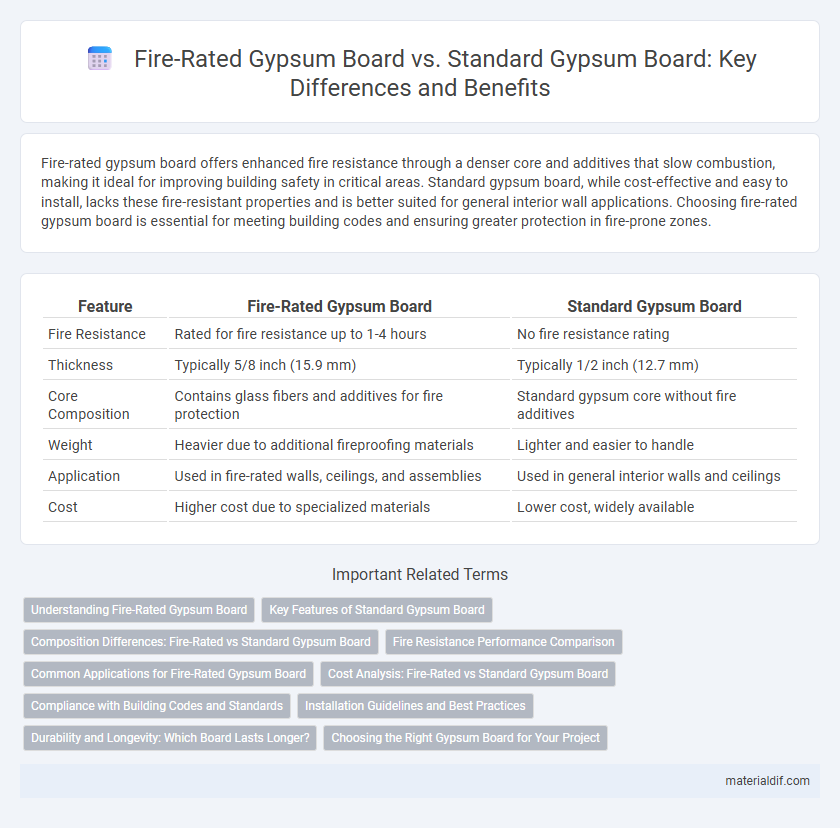Fire-rated gypsum board offers enhanced fire resistance through a denser core and additives that slow combustion, making it ideal for improving building safety in critical areas. Standard gypsum board, while cost-effective and easy to install, lacks these fire-resistant properties and is better suited for general interior wall applications. Choosing fire-rated gypsum board is essential for meeting building codes and ensuring greater protection in fire-prone zones.
Table of Comparison
| Feature | Fire-Rated Gypsum Board | Standard Gypsum Board |
|---|---|---|
| Fire Resistance | Rated for fire resistance up to 1-4 hours | No fire resistance rating |
| Thickness | Typically 5/8 inch (15.9 mm) | Typically 1/2 inch (12.7 mm) |
| Core Composition | Contains glass fibers and additives for fire protection | Standard gypsum core without fire additives |
| Weight | Heavier due to additional fireproofing materials | Lighter and easier to handle |
| Application | Used in fire-rated walls, ceilings, and assemblies | Used in general interior walls and ceilings |
| Cost | Higher cost due to specialized materials | Lower cost, widely available |
Understanding Fire-Rated Gypsum Board
Fire-rated gypsum board contains special additives and glass fibers that enhance its resistance to fire, allowing it to withstand higher temperatures and prevent the spread of flames for up to two hours. This type of gypsum board is commonly used in commercial buildings, schools, and hospitals where fire safety regulations mandate enhanced protection. Standard gypsum board lacks these fire-resistant properties, making it suitable primarily for interior walls and ceilings without stringent fire performance requirements.
Key Features of Standard Gypsum Board
Standard gypsum board features a core made of gypsum plaster sandwiched between two layers of paper, providing a smooth surface ideal for interior walls and ceilings. It offers moderate fire resistance but does not meet the strict fire-rating requirements for commercial or high-risk areas. Commonly used in residential construction, it supports easy installation, paint application, and finishing techniques like taping and sanding.
Composition Differences: Fire-Rated vs Standard Gypsum Board
Fire-rated gypsum board contains glass fibers and other additives that enhance its fire resistance, whereas standard gypsum board primarily consists of a gypsum core with paper facings. The glass fibers in fire-rated boards improve structural integrity during high temperatures, preventing rapid breakdown. Standard gypsum board lacks these fire-retardant additives, making it less effective in slowing fire spread.
Fire Resistance Performance Comparison
Fire-rated gypsum board contains non-combustible fibers and additives that enhance its ability to withstand high temperatures, providing up to 1-4 hours of fire resistance depending on thickness and type. Standard gypsum board, while offering some inherent fire resistance due to its gypsum core, typically resists fire for only about 30 minutes to 1 hour under similar conditions. Fire-rated boards are specifically engineered to meet strict building codes for fire safety, making them essential in areas requiring enhanced protection.
Common Applications for Fire-Rated Gypsum Board
Fire-rated gypsum board is commonly used in commercial buildings, schools, hospitals, and industrial facilities where enhanced fire resistance is mandatory to meet local building codes and safety standards. It is ideal for walls, ceilings, and partitions that require a specific fire-resistance rating, including fire barriers and shaft enclosures. These applications prioritize protecting occupants and property by slowing fire spread and providing critical time for evacuation and emergency response.
Cost Analysis: Fire-Rated vs Standard Gypsum Board
Fire-rated gypsum board typically costs 20-30% more than standard gypsum board due to its enhanced fire-resistant core and additional layers that comply with safety regulations. While the initial investment is higher, fire-rated boards can reduce long-term expenses by minimizing fire damage and insurance premiums. Standard gypsum board remains a cost-effective choice for non-critical areas but lacks the protective benefits essential for fire-rated construction zones.
Compliance with Building Codes and Standards
Fire-rated gypsum board is engineered to meet stringent building codes like ASTM E119 and UL 263, ensuring enhanced fire resistance for walls and ceilings in commercial and residential constructions. Standard gypsum board typically complies with general safety standards but does not offer the same level of fire protection required by fire-rated assemblies. Compliance with local building codes often mandates the use of fire-rated gypsum in designated areas to achieve required fire-resistance ratings and occupant safety.
Installation Guidelines and Best Practices
Fire-rated gypsum board requires careful installation following specific guidelines to maintain its fire-resistance rating, such as proper fastening patterns, use of compatible joint compounds, and sealing of all joints and penetrations with fire-resistant materials. Standard gypsum board installation prioritizes ease and speed but does not emphasize fireproofing, often using common drywall screws and standard joint tapes without fire sealants. Adhering to manufacturer instructions and local fire codes is crucial for fire-rated boards to ensure maximum safety and compliance.
Durability and Longevity: Which Board Lasts Longer?
Fire-rated gypsum board contains glass fibers and additives enhancing its resistance to heat and moisture, resulting in greater durability compared to standard gypsum board. Standard gypsum board is susceptible to damage from prolonged exposure to moisture and fire, which compromises its structural integrity over time. Fire-rated gypsum board's reinforced composition ensures longer-lasting performance in environments with potential fire hazards, offering extended longevity and reliability.
Choosing the Right Gypsum Board for Your Project
Fire-rated gypsum board offers enhanced fire resistance due to its glass fibers and special core additives, providing up to 1-4 hours of protection compared to standard gypsum board's limited fire resistance. Selecting the right gypsum board depends on project requirements such as building codes, fire safety standards, and environmental conditions, ensuring compliance and optimal performance. Fire-rated gypsum boards are essential for commercial spaces, stairwells, and areas needing stringent fireproofing, while standard boards suit interior walls and ceilings without high-risk fire exposure.
Fire-rated gypsum board vs Standard gypsum board Infographic

 materialdif.com
materialdif.com